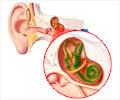What is Labyrinthectomy?
Labyrinthectomy is the surgical removal of the labyrinth of the inner ear, which is made up of the vestibule, semicircular canals, and cochlea. It is a destructive procedure used for treating Meniere’s disease. Labyrinthectomy, which was developed over a century ago for controlling intractable vertigo, still remains one of the best procedures for destroying vestibular function in a diseased ear.
Labyrinthectomy involves complete removal of the balance organs and soft tissues of the vestibule. As a result, no signals pass into the brain from regions of the inner ear that sense changes in motion and gravity. During surgery, since hearing is lost due to removal of the cochlea, the procedure is reserved for patients with non-serviceable hearing in the operated ear. This procedure is not frequently used nowadays as preservation of hearing during treatment has become the norm. However, labyrinthectomy remains the ‘Gold Standard’ for treating disabling episodic vertigo in unilateral Meniere’s disease patients, as well as other forms of Intractable vertigo. It has a success rate of over 90 percent.
Anatomy & Physiology of the Inner Ear
The Inner ear is made up of the bony labyrinth, which has several parts, namely, the cochlea, semicircular canals, and the vestibule. The Cochlea is responsible for hearing, while the semicircular canals and vestibule, which collectively constitute the vestibular system, are responsible for balance. The Vestibular system is lined with a membrane that contains sensory receptors, which contribute to maintaining balance by sensing changes in linear motion, rotation and gravity. Damage to these structures due to disease or injury can result in loss of balance, giving rise to vertigo.
What are the Types of Labyrinthectomy?
There are two basic types of Labyrinthectomy – Trans-canal and Trans mastoid. Besides these, there is another procedure called Chemical Labyrinthectomy, which is not a labyrinthectomy in the true sense of the term, as it does not involve surgery. These are briefly discussed below:
- Trans canal Labyrinthectomy: In this procedure, the vestibule is accessed through a surgical incision in the Tympanic membrane or Eardrum (tympanotomy), followed by removal of the ‘Stapes’ bone, and drilling through the bone adjacent to the vestibule. The Neuroepithelium is then removed using a hook and suction
- Trans mastoid Labyrinthectomy: In this procedure, the semicircular canals and vestibule are opened-up and the neuroepithelium is cut-away, under direct visualization
- Chemical Labyrinthectomy: This procedure uses the antibiotic Gentamicin, which is infused into the middle ear and is absorbed through the round window (opening between the middle and inner ears) into the vestibule. Gentamicin destroys the vestibular hair cells, thereby preventing impulses from passing into the brain. This procedure is hence also called as Intratympanic Gentamicin therapy.
Who Should Undergo Labyrinthectomy?
Labyrinthectomy is recommended in the following individuals:
- Patients who have poor or non-serviceable hearing
- Elderly patients, usually above 60 years of age
- Patients in whom intracranial procedures cannot be carried out
- Patients in whom conservative treatment modalities have failed
- Patients in whom hearing-sparing surgery has not been successful
- Patients who suffer from severe disability related to Meniere’s disease











